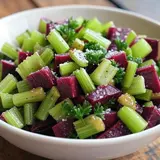
Celery and Beetroot Salad

There's something captivating about discovering recipes from bygone eras. Today, we're sharing a remarkably simple salad that has stood the test of time.
This salad comes from Homely Hints on Diet and Cookery, a cookbook published in 1902 and attributed to the mysterious Monsieur Alfonse. Despite the book's enduring appeal, very little is known about who Monsieur Alfonse actually was, or indeed if he was a real person at all. This touch of mystery only adds to the charm of this vintage recipe.
What emerges from these instructions is a vibrant salad that balances earthy sweetness with crisp freshness. The deep ruby cubes of beetroot create a visual contrast with the pale celery pieces. The recommended dressing is an early version of what we now recognize as a classic vinaigrette, with the piquancy of mustard adding depth to a straightforward oil and vinegar base.
The option to use either raw or lightly boiled celery is particularly interesting; raw would provide a refreshing crunch, while gently cooked celery would offer a softer texture that might better absorb the dressing. Either way, the combination creates a beautiful harmony of flavors and textures. Although the recipe does not specify the preparation of the beets, it should be understood that the beets are cooked. Raw beets are not generally edible.
Beetroot, the star ingredient of this salad, has been cultivated since ancient times. This remarkable root vegetable is not only visually striking but also incredibly nutritious. It is rich in nitrates, which can help lower blood pressure, along with betalains, which are powerful antioxidants that give beets their distinctive color. Beetroots are also an excellent source of folate and fiber. Ancient Romans even considered beetroot to be an aphrodisiac, and throughout history, beetroot juice has been used as a natural food coloring, and even as a cosmetic blush for cheeks and lips. This salad recipe shows that even in 1902, home cooks appreciated the vibrant beauty and distinctive flavor of this remarkable root.
While this recipe stands perfectly well on its own, modern palates might enjoy a few additions such as a sprinkle of fresh herbs (dill pairs wonderfully with beets), some crumbled feta or goat cheese, or perhaps a handful of toasted walnuts for extra texture and nutty flavor. The instructions tell us to “break” the celery in order to create rough pieces, but we find that a fine dice is actually easier to eat and more visually appealing.
Whether served as written or with contemporary embellishments, this salad is a taste of culinary history: proof that simple, quality ingredients prepared with care never go out of style. Our quantity recommendations, below, should be interpreted per person.
- 1 beet, cooked
- 1 celery stalk
- 2 tbsp. salad oil, like olive
- 1 tbsp. vinegar
- 1 tsp. mustard
- Salt
- Pepper
Cut the beetroot into small pieces about the size of an average lump of sugar ; break the celery into pieces about an inch long. Mix with the plain dressing. The celery can be raw, or boiled—not over boiled.
The best plain salad dressing is : —two parts of best salad oil to one of vinegar. In the vinegar, say for example a tablespoonful—stir a mustard-spoonful of French mustard (or ordinary English), a pinch of salt and a dash of pepper. Then stir in the oil.